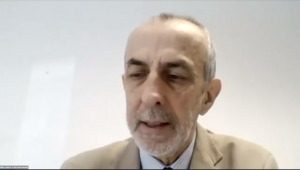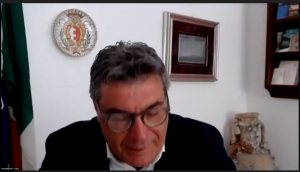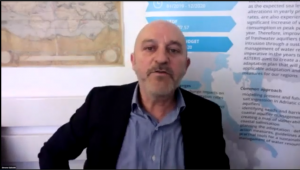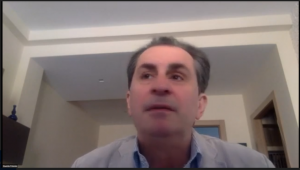The Adriatic and Ionian Fora of Chambers of Commerce, Universities and Cities and their members, in cooperation with Adriatic and Ionian Initiative – Chairmanship of the Republic of Slovenia organized three online Round Tables as Side-Events within the framework of the 6th EUSAIR Forum.
The webinars analyzed and discussed three main topics: Climate Change, Blue Economy and Circular Economy. The Webinar “Saline intrusion: a potential risk for coastal aquifer management in a changing climate”, which was held on May 10, was organized in collaboration with the Municipality of Fano and the University of Urbino.
The meeting opened with greetings from the Ambassador Milan Jazbec – AII Chairman-in-office, Ministry of Foreign Affairs of the Republic of Slovenia who stressed the importance of this detailed and particular topic and also connected to all areas of environment, green economy, digital management and digitalization and complementary to the priorities to the Slovenian Presidency that will start soon. This argument was a very good example of cooperation of Civil Society, business and academic environment.
Ambassador Fabio Pigliapoco, Secretary General of the Adriatic Ionian Initiative thanked the Fora and their work for organizing these interesting events and renewed his support to this long and precocious collaboration with Fora.
The Mayor of Fano, and Vice President of FAIC, Massimo Seri brought the greeting of the President of FAIC, Iaonnis Lolos, who shared the common will to always be proactive with respect to those initiatives, in terms of international cooperation and in terms of the exchange of ideas and good practices.
The Mayor added that the theme of the meeting is concrete and tangible, and interventions that the City of Fano was able to carry out thanks to the collaboration between local municipal administrations, local authorities, the scientific world and economic operators, but also thanks to the territorial cooperation of the Adriatic Ionian Macroregion.
Prof. Simone Galeotti – University of Urbino, member of UniAdrion, Lead Partner of ASTERIS Project welcomed the participants to the session and thanked for be here to discuss this very much target but important saline intrusion topic. The projects discussed in this session are expression of integration and cooperation of transnational frontier.
The first techinal session was moderate by Maurizio Polemio – National Research Council – Research Institute for Geo-Hydrological Protection (CNR-IRPI).
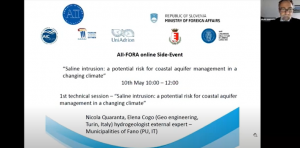 Nicola Quaranta (Geo engineering, Turin, Italy) – hydrogeologist external expert focused on case study of Fano and Ravenna and offered a view of best practises in order to face the saline intrusion problem in a context of climate change. First at all, the best practises were selected by a low -CO2 emission criteria and they are:
Nicola Quaranta (Geo engineering, Turin, Italy) – hydrogeologist external expert focused on case study of Fano and Ravenna and offered a view of best practises in order to face the saline intrusion problem in a context of climate change. First at all, the best practises were selected by a low -CO2 emission criteria and they are:
– Knowledge heterogeneity (spatial&time-depending) of aquifer salinization could be solve by making knowledge systematic and capillary-diffused and implementing the “SWI” – WEB-GIS (National-Regional Environmental Agencies),
– In term of exploitation of groundwater bodies “with poor quantitative control”, it is necessary to re-orienteering groundwater pumping and facilitate deepening of interface zone;
– The climate change (temperature-rain => ETP/I distribution) could be faced with a facilitation of infiltration and storage of surface run-off;
– The setback of the coast line could be contrasted by an active practices against shoreline erosion;
– Agricultural & Wet-zone coastal management could be oriented to use a selection of plants/crops tolerant to salt limits.
Then Prof. Quaranta explained the adaptation plan as a result included in the Asteris project. Implementing an adaptation plan is important in order to protect the beach from sea level rise and storm surge frequency, to protect the ground water resources for different uses (drinking, irrigation, industrial, domestic), to maintain underground infrastructures (technological networks, sewers etc.) and buildings (underground rooms, foundations etc.) and to protect the Coastal bio-diversity (where applicable / sensitive).
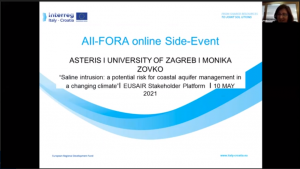 Monika Zovko, PhD from the University of Zagreb (Croatia), on behalf of IACKR – Institute for Adriatic Crops and Karst Reclamation, Croatian ASTERIS project partner and expert in Geo-statistical techniques for salinity mapping and remote sensing, introduced a case study carried out in the Neretva Valley for the purpose of identifying needs and barriers in coastal aquifer management, within the project Asteris. With that aim, available historical data were collected and elaborated (water chemical and physical analysis) in order to determine a degree of the ground and underground waters salinity and to identify trends; a land use, pedological and soil salinity maps were prepared; national monitoring data (hydrological and chemical) were collected in collaboration with Croatian Waters and processed; short-term monitoring established in 10 locations during dry and wet seasons (22 points of monitoring: 15 points in surface streams and 7 piezometrc points); laboratory tests implemented with regards to ionic composition and isotopes δ18O and δD.
Monika Zovko, PhD from the University of Zagreb (Croatia), on behalf of IACKR – Institute for Adriatic Crops and Karst Reclamation, Croatian ASTERIS project partner and expert in Geo-statistical techniques for salinity mapping and remote sensing, introduced a case study carried out in the Neretva Valley for the purpose of identifying needs and barriers in coastal aquifer management, within the project Asteris. With that aim, available historical data were collected and elaborated (water chemical and physical analysis) in order to determine a degree of the ground and underground waters salinity and to identify trends; a land use, pedological and soil salinity maps were prepared; national monitoring data (hydrological and chemical) were collected in collaboration with Croatian Waters and processed; short-term monitoring established in 10 locations during dry and wet seasons (22 points of monitoring: 15 points in surface streams and 7 piezometrc points); laboratory tests implemented with regards to ionic composition and isotopes δ18O and δD.
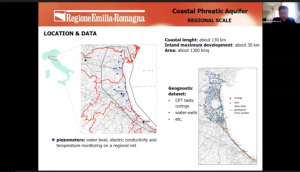 Lorenzo Calabrese – Emilia Romagna Region – Geological, Seismic and Soil Survey (“Hydrogeological characterization and saltwater intrusion in coastal phreatic aquifer of Emilia–Romagna Region, Italy”) illustrated the work done with his collogues within the Emilia Romagna region called Hydrogeological characterization and salt water intrusion in coastal phreatic aquifer of Emilia – Romagna Region. The study was based on regional and local scale. On regional scale the coastal phreatic aquifer was present long the entire coast for 130 km and its presence in the inland was variable. One of the result of the study was a reconstruction of the aquifer limits and characteristic (top and bottom surfaces; thickness) done thanks to a monitoring activity from 2009 to nowadays. On local scale, in particular on the Ravenna coastal plain, on the occasion of the GEOERA –TACTIC PROJECT, coastal studies were made with other technologies: detailed geolithological 3D reconstruction, hydrogeological parameters from CPT, EC & T 3D maps.
Lorenzo Calabrese – Emilia Romagna Region – Geological, Seismic and Soil Survey (“Hydrogeological characterization and saltwater intrusion in coastal phreatic aquifer of Emilia–Romagna Region, Italy”) illustrated the work done with his collogues within the Emilia Romagna region called Hydrogeological characterization and salt water intrusion in coastal phreatic aquifer of Emilia – Romagna Region. The study was based on regional and local scale. On regional scale the coastal phreatic aquifer was present long the entire coast for 130 km and its presence in the inland was variable. One of the result of the study was a reconstruction of the aquifer limits and characteristic (top and bottom surfaces; thickness) done thanks to a monitoring activity from 2009 to nowadays. On local scale, in particular on the Ravenna coastal plain, on the occasion of the GEOERA –TACTIC PROJECT, coastal studies were made with other technologies: detailed geolithological 3D reconstruction, hydrogeological parameters from CPT, EC & T 3D maps.
The second techinal session was moderate by Ivana Kristovic – DNZ (Hr) that introduced the WATERCARE project. The speakers for the session were: Luigi Bolognini – Marche Region (It), Antonella Penna – University of Urbino (It) and Ivo Duracic – DNZ (Hr).
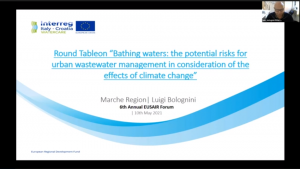 Luigi Bolognini presented “Bathing waters: the potential risks for urban waste water management in consideration of the effects of climate change” and he focused on the Italian case, talking about the effect of climate change in the urban areas, such as an irregular distribution of rain in last years, that caused a malfunctions of sewer network. This could effect the level of bacterial contamination in coastal waters and the bathing closure are implemented. Bolognini presented the possible solution for the problem: REDUCTION OF HYDRAULIC LOADS (rainwater drainage systems separated from sewers) and ARU REMOVAL FROM SENSITIVE SITES (second rain urban waste water removal system)
Luigi Bolognini presented “Bathing waters: the potential risks for urban waste water management in consideration of the effects of climate change” and he focused on the Italian case, talking about the effect of climate change in the urban areas, such as an irregular distribution of rain in last years, that caused a malfunctions of sewer network. This could effect the level of bacterial contamination in coastal waters and the bathing closure are implemented. Bolognini presented the possible solution for the problem: REDUCTION OF HYDRAULIC LOADS (rainwater drainage systems separated from sewers) and ARU REMOVAL FROM SENSITIVE SITES (second rain urban waste water removal system)
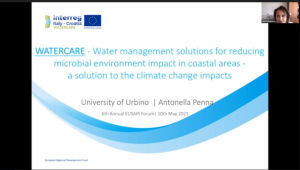 Antonella Penna presented the project WATERCARE. The essential goal of the project was improving the bath water quality by reducing the risk of microbial contamination and through the use of innovative tools for the treatment and management of coastal waters. Then, she focused on the aims of the project: developing an innovative system for water quality named Water Quality Integrates System (WQIS) based on a real-time hydro-meteorological monitoring system and on an operational forecasting model (FOM); creating an hoc infrastructure, a setting tank fo sewer waters, for the bathing water management in the pilot site of Fano (Arzilla riverine) in order to reduce bacterial contamination of Escherichia coli and intestinal Enterococci in coastal waters, and consequently improving water management in urban areas; developing a real-time alert system, able to prevent the potential ecological risk from microbial contamination of bathing and support decision-making processes in bathing water management; extending the approach to 4 other coastal sites ( Rasa River-istria, Catina river-Split, Neretva River-Dubvrovnik, Pescara River- Pescara) in order to improve the planning and management of environmental problems of the coastal bathing waters.
Antonella Penna presented the project WATERCARE. The essential goal of the project was improving the bath water quality by reducing the risk of microbial contamination and through the use of innovative tools for the treatment and management of coastal waters. Then, she focused on the aims of the project: developing an innovative system for water quality named Water Quality Integrates System (WQIS) based on a real-time hydro-meteorological monitoring system and on an operational forecasting model (FOM); creating an hoc infrastructure, a setting tank fo sewer waters, for the bathing water management in the pilot site of Fano (Arzilla riverine) in order to reduce bacterial contamination of Escherichia coli and intestinal Enterococci in coastal waters, and consequently improving water management in urban areas; developing a real-time alert system, able to prevent the potential ecological risk from microbial contamination of bathing and support decision-making processes in bathing water management; extending the approach to 4 other coastal sites ( Rasa River-istria, Catina river-Split, Neretva River-Dubvrovnik, Pescara River- Pescara) in order to improve the planning and management of environmental problems of the coastal bathing waters.
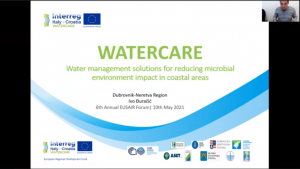 Ivo Duracic – DNZ (Hr) focused the attention on the other aspects of the project, such as target group, dissemination tactics and beneficiaries. The target groups of the WATERCARE project included many recipients, from general to public local authorities, SMEs, NGOs, universities and research institutes, while the disseminate tactics were: newsletter, leaflets guidelines, media campaign, presentation at conferences, public events and publication in technical journals. The beneficiaries of the activities of the project included coastal zone managers, public authorities, stakeholders, operators of the facilities, tourist services, swimmers and bathers, tourists and citizen.
Ivo Duracic – DNZ (Hr) focused the attention on the other aspects of the project, such as target group, dissemination tactics and beneficiaries. The target groups of the WATERCARE project included many recipients, from general to public local authorities, SMEs, NGOs, universities and research institutes, while the disseminate tactics were: newsletter, leaflets guidelines, media campaign, presentation at conferences, public events and publication in technical journals. The beneficiaries of the activities of the project included coastal zone managers, public authorities, stakeholders, operators of the facilities, tourist services, swimmers and bathers, tourists and citizen.
The debate will continue in the group that will be created within the Stakeholder Platform, in which the presentations of the speakers and the recording of the event will be uploaded.
Here the presentations of the Speakers:
ZOVKOZOVKO

